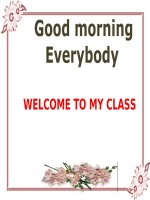Unit 10 Communication Lesson 7 Looking back project
Bạn đang xem bản rút gọn của tài liệu. Xem và tải ngay bản đầy đủ của tài liệu tại đây (104.96 KB, 5 trang )
<span class='text_page_counter'>(1)</span>UNIT 10: COMMUNICATION. PERIOD 89: lesson 7: looking back and project. I) Objectives : 1. Educational aim : By the end of the lesson, Ss will be able: - Use the words to talk about communication. - Use the words and phrases to complete the sentences. 2. Knowledge: - Vocabulary : words related the topic. - Grammatical structures lexical items related the topic. II) Teaching aids : Text books, cassette, chalk, visual pictures and some boards. III) Procedure : Steps & ttime A. Warm up ( 5’). Learning activities. LOOKING BACK Encourage Ss not to refer back to the unit. Ask them to keep a record of their answers to each exercise so that thay can use that information to complete the self – assessment box at the unit. B. Looking Vocabulary back 1. Complete the sentences using the cues provided. Ask Ss to complete the sentences by using the support from the picture, the letter cues, and the meaning of the sentences. They work individually first and then compare with a partner. Key: 1. body language 2. Multimedia 3. Face - to - face 4. cultural differences 5. Telepathy 6. Netiquette 2. Write the following text messages/ chat lines in shorthand form. Challenge Ss to try this task without looking back at COMMUNICATION. Have two or three Ss write their answers on the board Key: 1. Thx 4 ur gift 2. BTW, wot r u doin this wkd? 3. Pls call me rite now 4. LOL! 5. C U 2nite. 3. Have you ever used music, art, codes, signs or any non – verbal ways to communicate? Tell a partner what you did. Was the communication successful?. Language focus. Models class work. 1. body language individually 2. Multimedia 3. Face - to pair work - face 4. cultural differences 5. Telepathy 6. Netiquette individually pair work 1. Thx 4 ur gift 2. BTW, wot r u doin this wkd? 3. Pls call me rite now 4. LOL!.
<span class='text_page_counter'>(2)</span> Ss work in pairs for this task. Remind Ss that these are non – verbal ways of communication. Then call on some pairs to report their talk. Grammar 4. Underline the correct answer. Ss work individually then in pairs to compare their answers. Key: 1. will not be sleeping 2. Will be playing 3. Will he be doing 4. will be waiting 5 will not be using; will be using 6. Will be raining 5. Gerund or to - infinitive? Ss work individually then in pairs to compare their answers. If time allows encourage Ss to think of other verbs that are followed by gerunds and by to - infinitives and make sentences using them. Key: 1. talking 2. To use 3. To show 4. communicating 5. Chatting 6. To have C. Communication Performing 6 Ss discuss this task in pairs. Remind them that they can choose to talk about forms of communication people will be using or will not be using in the year 2100 and they should give the reasons why they think so. For a more able class, this can be done as a debate if some particular forms of communication are selected beforehand for Ss to discuss. Ask Ss to complete the self - assessment box. Identify any difficulties or weak areas and provide further practice. 6 Choose any three forms of communication in this unit and work with a partner to decide if people will be using them in the year 2100 or not. Give at least two reasons for each decision. PROJECT PROJECT “Action. Take one! Action. Take two!” Remind Ss of: - The reasons for communication breakdown in COMMUNICATION - different ways of communicating in GETTING STARTEDand A CLOSER LOOK. 5.CU 2nite.. individually The future pair work continous tense Gerund or to infinitive. individualy pair work. past simple individually or past perfect groupwork.
<span class='text_page_counter'>(3)</span> 1 Put them into groups and ask them to think of a sketch or a role – play of a communication breakdown. Give them time to brainstorm some ideas. Move around the class, giving help where necessary. Alternatively, T can prepare the following scenarios if Ss are short of ideas or time. Print each sketch on a piece of paper and fold it up. Each group will pick one piece of paper and prepare their performance. More than one group can have the same sketch, because they will interprete it differently. Ss may prepare the sketch out of class if more time is needed. On the performance day, more than one group may act out a similar play, put look for their different interpretation of the communication breakdown as well as their solution. Make sure everyone gives each group lot of encouragement and praise for their acting attempts. Sketch 1 The confused teacher Susan is a teacher from London who comes to a small town in Viet Nam to teach English. She has her first lesson today and is very impressed by one of her students – Lien. Lien speak English very well and is very active in the class. Later that day Susan runs into Lien in the corridor. Susan wants to compliment Lien and she says, ‘Lien, your English is excellent!’. And Lien answers ‘No it’s very bad!’ Susan feels rather confused and she doesn’t know why Lien responds to her this way. Sketch 2 The best restaurant Jerry and Diana are from the USA and they are now on holiday in France. They eat out in a restaurant and they find the food and the wine excellent. At the end of the meal the chef asks how they have enjoyed the evening and Jerry holds up his thumb and index finger to make a circle. Seeing that, the chef’s face suddenly falls and he leaves immediately without a word. Jerry and Diana are left wondering what they have done wrong. Sketch 3 The missing fork and the giant drink. pair work.
<span class='text_page_counter'>(4)</span> Hoang Ly is from Ha Noi and now she’s visiting her grandparents in Ho Chi Minh City. Minh Anh, her friend in Ho Chi Minh City is talking her to eat out. When the food is brought out, Ly notices there is one fork missing on the table, so she asks the waiter for one. ‘Chú mang hộ cháu một cái dĩa nữa được không ạ?’. Then the waiter bring her a big plate. Ly thinks perhaps the restaurant is too noisy and the waiter couldn’t hear what she said. After that, Minh Anh comes and visits Ly’s grandparents. They offer her tea and Minh Anh hears Ly’s grandmother telling her, ‘Cháu vào lấy thêm một cái chén nữa cho Minh Anh’. Minh Anh is a bit nervous because she doesn’t feel like she wants to drink such a huge bowl of tea, especially after her big meal with Hoang Ly. Key: (NB. Encourage each group to try to find their own reasons and provide these keys only if they ask for help.) Sketch 1 Communication breakdown = cultural differences In Viet Nam it is typical to deny the compliments you receive. This is a way to show your modesty. However, in western cultures, people who give compliments often expect you to take about them, and denial of compliments, especially if it is repeated, may be rude and make the other person feel uncomfortable. In this situation, Lien may just politely thank her teacher. Sketch 2 Communication breakdown = cultural differences In the USA, holding up one thumb and index finger to maker a circle means OK, good, excellent, while in France, this gesture means something not so good, event worthless. Sketch 3 Communication breakdown = language barrier When the people in Ha Noi and some other provinces in northern Viet Nam say ‘dĩa’ they mean a fork, while this word means a palate for the people in southern Viet Nam. Meanwhile, ‘chén’ in northern Viet Nam means a small teacup whereas in southern Viet Nam the.
<span class='text_page_counter'>(5)</span> word means a bowl you use to eat when having D. meals. Homework - Do all the ex again.. Whole class. *Feedback: ………………………………………………………………………………………… …………………………………………………………………………….
<span class='text_page_counter'>(6)</span>









